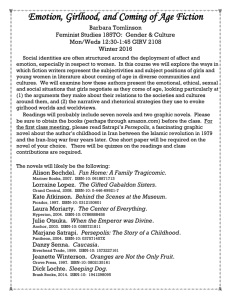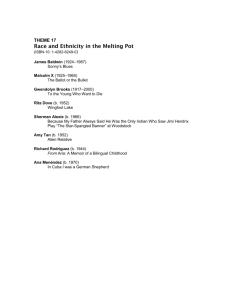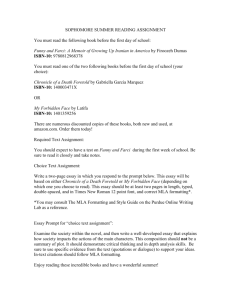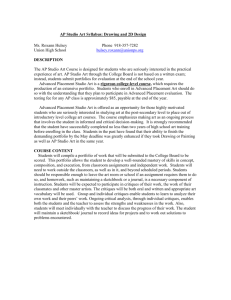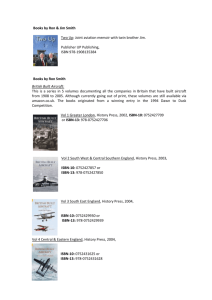Course Syllabus for the 2D Design Portfolio
advertisement
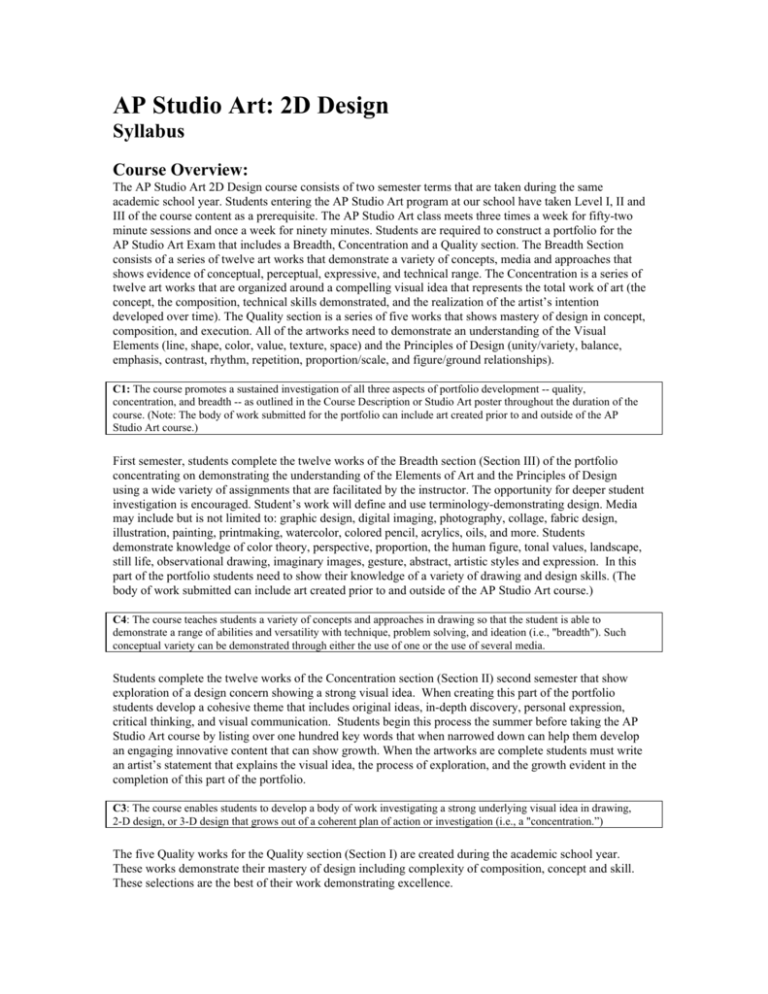
AP Studio Art: 2D Design Syllabus Course Overview: The AP Studio Art 2D Design course consists of two semester terms that are taken during the same academic school year. Students entering the AP Studio Art program at our school have taken Level I, II and III of the course content as a prerequisite. The AP Studio Art class meets three times a week for fifty-two minute sessions and once a week for ninety minutes. Students are required to construct a portfolio for the AP Studio Art Exam that includes a Breadth, Concentration and a Quality section. The Breadth Section consists of a series of twelve art works that demonstrate a variety of concepts, media and approaches that shows evidence of conceptual, perceptual, expressive, and technical range. The Concentration is a series of twelve art works that are organized around a compelling visual idea that represents the total work of art (the concept, the composition, technical skills demonstrated, and the realization of the artist’s intention developed over time). The Quality section is a series of five works that shows mastery of design in concept, composition, and execution. All of the artworks need to demonstrate an understanding of the Visual Elements (line, shape, color, value, texture, space) and the Principles of Design (unity/variety, balance, emphasis, contrast, rhythm, repetition, proportion/scale, and figure/ground relationships). C1: The course promotes a sustained investigation of all three aspects of portfolio development -- quality, concentration, and breadth -- as outlined in the Course Description or Studio Art poster throughout the duration of the course. (Note: The body of work submitted for the portfolio can include art created prior to and outside of the AP Studio Art course.) First semester, students complete the twelve works of the Breadth section (Section III) of the portfolio concentrating on demonstrating the understanding of the Elements of Art and the Principles of Design using a wide variety of assignments that are facilitated by the instructor. The opportunity for deeper student investigation is encouraged. Student’s work will define and use terminology-demonstrating design. Media may include but is not limited to: graphic design, digital imaging, photography, collage, fabric design, illustration, painting, printmaking, watercolor, colored pencil, acrylics, oils, and more. Students demonstrate knowledge of color theory, perspective, proportion, the human figure, tonal values, landscape, still life, observational drawing, imaginary images, gesture, abstract, artistic styles and expression. In this part of the portfolio students need to show their knowledge of a variety of drawing and design skills. (The body of work submitted can include art created prior to and outside of the AP Studio Art course.) C4: The course teaches students a variety of concepts and approaches in drawing so that the student is able to demonstrate a range of abilities and versatility with technique, problem solving, and ideation (i.e., "breadth"). Such conceptual variety can be demonstrated through either the use of one or the use of several media. Students complete the twelve works of the Concentration section (Section II) second semester that show exploration of a design concern showing a strong visual idea. When creating this part of the portfolio students develop a cohesive theme that includes original ideas, in-depth discovery, personal expression, critical thinking, and visual communication. Students begin this process the summer before taking the AP Studio Art course by listing over one hundred key words that when narrowed down can help them develop an engaging innovative content that can show growth. When the artworks are complete students must write an artist’s statement that explains the visual idea, the process of exploration, and the growth evident in the completion of this part of the portfolio. C3: The course enables students to develop a body of work investigating a strong underlying visual idea in drawing, 2-D design, or 3-D design that grows out of a coherent plan of action or investigation (i.e., a "concentration.”) The five Quality works for the Quality section (Section I) are created during the academic school year. These works demonstrate their mastery of design including complexity of composition, concept and skill. These selections are the best of their work demonstrating excellence. C2: The course enables students to develop mastery (i.e., "quality") in concept, composition, and execution of drawing. Students are required to keep a sketchbook that will contain class notes, handouts, articles, brainstorming ideas, journaling and to create thumbnails for project plans. This tool will enable students to develop their concepts in an informal manner. Students are required to visit local museums and art galleries reflecting upon their impressions in their sketchbooks. C5: The course emphasizes making art as an ongoing process that involves the student in informed and critical decision making. All of the students’ artwork will be evaluated according to the AP Studio Art Scoring guidelines that rate pieces from one to six. C6: The course includes group and individual student critiques and instructional conversations with the teacher, enabling students to learn to analyze and discuss their own artworks and those of their peers. Students are always encouraged to draw from observation and are not allowed to plagiarize images. The AP Studio Art course is built on integrity and work ethics meeting deadlines. C7: The course teaches students to understand artistic integrity as well as what constitutes plagiarism. If students produce work that makes use of photographs, published images, and/or other artists' works, the course teaches students how to develop their own work so that it moves beyond duplication. Student Learning: Students begin the course with six summer assignments and a reading. They also construct a list of 100 topics that can be considered for the concentration before returning to school. Summer Assignments: • Week 1 The Reading: The Blank Canvas by Anna Held Audette Students will need to email the instructor 5 reflective writings about the book content. Explore the following urls: • The AP Studio Art website at AP Central http://www.collegeboard.com/student/testing/ap/sub_studioart.html?studioar • The AP Studio Art Classroom website http://www1.dcsdk12.org/secondary/mvhs/staffwebpages/wilson/artdept/ap.htm C5: The course emphasizes making art as an ongoing process that involves the student in informed and critical decision making. • Week 2 Take photographs of landscapes, architecture, reflective objects, people, animals, and more from unique perspectives with dramatic lighting. • Week 3 Start a sketchbook, or an altered book recording your interests to create a visual diary. • Week 4 Draw, paint or photograph the Visual Elements (line, shape, color, value, texture, space) and the Principles of Design (unity/variety, balance, emphasis, contrast, rhythm, repetition, proportion/scale, and figure/ground relationships) that you discover in your surroundings or places you travel to. • Week 5 Create a list of 100 topics that you might use for a theme for your concentration. When school starts we will find connections to narrow your theme to a visual idea that you can develop. Fall Semester (First Term): To complete the Breadth portfolio students learn from teacher facilitated assignments, demonstrations, critiques, and digital slide shows over eighteen weeks of study. Guest artists will demonstrate technique and styles. C4: The course teaches students a variety of concepts and approaches in drawing so that the student is able to demonstrate a range of abilities and versatility with technique, problem solving, and ideation (i.e., "breadth"). Such conceptual variety can be demonstrated through either the use of one or the use of several media. • Week 1 Overview of computer software, camera basics, traditional media and art vocabulary • Week 2 Line, shape and texture; Typography; Word Project • Week 3 Logo/Symbol Design* • Week 4 Figure (positive)/ground (negative) space relationship, composition, illusion of depth on a two dimensional surface, rule of thirds, proportion, scale; Perspective Project • Week 5 Montage* • Week 6-7 Rhythm, pattern, movement, and repetition; Printmaking project • Week 8-9 Unity, variety, and balance; Radial Balance Design • Week 10-11 Color, value, and space; Color Project* • Week 12-13 Emphasis, exaggeration; Expressive or Abstract Self Portrait • Week 14-15 Advertisement/ Product Design, illustration, critique of professional designers • Week 16 Story or poem illustration* • Week 17 Social statement • Week 18 Poster design, professional presentation skills* At this point in the semester students will have a public and private portfolio review of their progress creating the Breadth part of their portfolio. * At the end of the semester students will go through a public and private portfolio review of their Breadth pieces. They will also take slides of their work and mat them for professional presentation. * *C6: The course includes group and individual student critiques and instructional conversations with the teacher, enabling students to learn to analyze and discuss their own artworks and those of their peers. Students will consider the following as they approach their work but they are not limited to: Students will use a variety of media including but not limited to: • The Elements of Art and the Principles of Design • Formalism • Emotionalism • Past/present/future • Spatial systems • Color theory, black and white media • Color psychology • Reflective surfaces • Metamorphosis • Positive/negative space relationships • Media developments • Vocabulary • Art history • Technology • Artist statements • Poster design • Abstract expressionism • Art Deco • Graphic design • Digital imaging • Photography • Collage • Illustration • Painting • Printmaking • Ink • Oil • Mixed media • Variety of surfaces • Colored pencil • Pastels • Acrylics • Watercolors Students will use a variety of concepts including but not limited to: • Deliberate distortions • Architectural space • Caricature • Action figures • Collage • Animals • Magnification • Reflective surfaces • Modular Design • Imaginary landscapes • Product design • Political cartoons • Fabric design • Fauvism • Industrial/mechanical • Landscape • Pop Art • Realism • Non-objective • Conceptual • Printmaking • Painting • Conflict Spring Semester: (Second Term) To complete the Concentration portfolio students complete student self-directed studies over seventeen weeks. The artwork needs to be expressive with personal content that speaks with the artist’s own voice. C3: The course enables students to develop a body of work investigating a strong underlying visual idea in drawing, 2-D design, or 3-D design that grows out of a coherent plan of action or investigation (i.e., a "concentration.”) • Week 1 – 2: Develop a theme that shows personal expression, unity and potential for growth through investigation and critical thinking. Visit local Art Museums to read artists’ statements and understand themes. Optional: Local gallery walks. C5: The course emphasizes making art as an ongoing process that involves the student in informed and critical decision making. • Week 3 -17: Students create the twelve pieces of artwork with receptivity to feedback to push their ideas and technique to higher levels of accomplishments. Students will have scheduled public and private portfolio reviews of their progress while creating the Concentration part of their portfolio. They will also take slides of their work and mat them for formal presentation. C6: The course includes group and individual student critiques and instructional conversations with the teacher, enabling students to learn to analyze and discuss their own artworks and those of their peers. • Week 18 Students organize their work for a professional presentation. Selection of their Quality pieces is determined and formal writing of their Concentration statement is completed. During the Spring Semester Seniors are required to participate in a “One Man Show” in the District’s Senior Portfolio Show to learn professional presentation, matting, selection process and layout. C5: The course emphasizes making art as an ongoing process that involves the student in informed and critical decision making. Assessments: All artwork is evaluated on craftsmanship, color, composition, contrast, cohesiveness, content, and the AP Scoring Guidelines provided by AP Central. AP Central Scoring Guidelines are posted at: http://apcentral.collegeboard.com/apc/members/exam/exam_questions/2182.html#name9 C5: The course emphasizes making art as an ongoing process that involves the student in informed and critical decision making. C6: The course includes group and individual student critiques and instructional conversations with the teacher, enabling students to learn to analyze and discuss their own artworks and those of their peers. Methods include: • Formative – Ongoing • Performance – Demonstration of skill and knowledge • Portfolio – Collection of work over time that shows knowledge, ability and growth. • Self Assessment – Student reflections of performance for the purpose of improvement. • Summative: “Tell me what you have learned.” • Journaling • Demonstration • Critique • Rubric • Conference • Artist’s Statement Criteria Based Rubric: Criteria Point Value Points Received Comments Total= 5 (100-90) Excellent Exceptional application and demonstration of criteria Insightful use of design elements and principles Masterful use of the techniques Purpose and direction is challenging and evident throughout the media, subject, & technique 4 (90-80) Strong Visible evidence of criteria 3 (80-70) Moderate Inconsistent evidence of criteria 2 (70-60) Weak Little evidence of criteria 1 (Re-do) No evidence of criteria. Strong understanding of design elements and principles Clean and consistent technique Purpose and direction is evident, but inconsistent Inconsistent use of design elements and principles No evidence of design elements and principles Inconsistent technical control Little evidence of incorporating design elements and principles Technical control is haphazard Inconsistent evidence of purpose and direction Purpose and direction is confusing and limited No evidence of purpose and direction No technical control evident Resources: • AP Studio Art Poster • AP Studio Art Teacher’s Guide Textbook: ArtTalk, Glencoe/McGraw-Hill; 4th edition (January 2, 2004), ISBN-10: 0078305993 Resource Books: A Practical Guide to Digital Design: Designing with Your Computer Made Easy, by Pina Lewandowsky and Francis Zeischegg, AVA Publishing (October 28, 2003) ISBN-10: 288479039X Adobe Photoshop CS2 Classroom in a Book, by Adobe Creative Team, Adobe Press; Pap/Cdr edition (May 24, 2005) ISBN-10: 0321321847 Design and Form: The Basic Course at the Bauhaus and Later, by Johannes Itten, Wiley; revised edition (December 1, 1975) ISBN-10: 0471289302 Design Basics, by David Lauer and Stephen Pentak, Wadsworth Publishing; 6th edition (February 23, 2004) ISBN-10: 0534625592 Design Manual, by Shirley J. Brainard, A (4th Edition), Prentice Hall; (March 30, 2005) ISBN-10: 0131931555 Design Principles and Problems, by Paul Zelanski and Mary Pat Fisher, Wadsworth Publishing; 3rd edition (February 2, 2007) ISBN-10: 0495094889 Design Synectics, by Nicholas Roukes, University of Calgary, Canada, Davis Pubns (September 1988). ISBN-10: 0871921987 Interaction of Color, by Josef Albers, revised edition, Yale University Press; (September 10, 1975) ISBN-10: 0300018460 Introduction to Design, by Alan Pipes, Prentice Hall (January 6, 2004) ISBN-10: 0131841068 Introduction to Digital Photography, by Joseph Ciaglia, (2nd edition) # Prentice Hall; (March 4, 2005) # Language: ISBN-10: 0131175157 Launching the Imagination: A comprehensive Guide to Basic Design, by Mary Stewart, 1st edition, McGraw-Hill Humanities/Social Sciences/Languages (January 11, 2002) ISBN-10: 007248540X Principles of Color Design, by Wucius Wong, Wiley; 2 Sub edition (September 26, 1996) ISBN-10: 0471287083 Principles of Form and Design, by Wucius Wong, Wiley (September 15, 1993) ISBN-10: 0471285528 The AP Vertical Teams Guide for Studio Art by College Board, © 2002. Order from the College Board The Art of Writing about Art, by Suzanne Hudson, University of Colorado at Boulder; Nancy NoonanMorrissey, University of Colorado at Boulder. Wadsworth Publishing; 1st edition (May 25, 2001). ISBN-10: 0155061542 The Artist's Handbook of Materials and Techniques, 5th edition, by Ralph Mayer, Viking Adult; (May 31, 1991). ISBN-10: 0670837016 The Blank Canvas, by Anna Held Audette, 1st edition (September 28, 1993). ISBN-10: 0877739382 The Creative Process: Reflections on the Invention in the Arts and Sciences, by Brewster Ghiselin, University of California Press; reissue edition (November 22, 1985) ISBN-10: 0520054539 The Elements of Color, by Johannes Itten, Wiley (January 31, 1970) ISBN-10: 0471289299 Understanding by Design, by Grant Wiggins and Jay McTighe, (2nd Edition), Prentice Hall; (April 1, 2005). ISBN-10: 0131950843 Visual Design on the Computer, by Wucius Wong and Benjamin Wong, 2nd edition, W. W. Norton & Company; (August 20, 2001) ISBN-10: 0393730611 Ways of Seeing: Based on the BBC Television, by John Berger, Penguin (Non-Classics); reprint edition (December 1, 1990) ISBN-10: 0140135154 What Can I Write About? by David Powell, National Council of Teachers of English; 2nd Updtd edition (November 2002). ISBN-10: 0814156541 Websites: AP Central: http://www.collegeboard.com/prof/index.html Art Cyclopedia: http://www.artcyclopedia.com/ Art History Resources on the Web: http://witcombe.sbc.edu/ARTHLinks.html Art Source: http://www.ilpi.com/artsource/museum.html Artlex: http://www.artlex.com/ Guggenheim: http://www.guggenheim.org/ Musee: http://www.musee-online.org/home.asp National Gallery of Art: http://www.nga.gov/ The Getty: http://www.getty.edu/education/ The Kennedy’s Center Artsedge: http://artsedge.kennedy-center.org/ The Metropolitan Museum of Art: http://www.metmuseum.org/ WebMuseum: http://www.ibiblio.org/wm/ Color Matters: http://www.colormatters.com/entercolormatters.html Masters/Illustrators in the Yahoo Directory: http://dir.yahoo.com/Arts/Visual_Arts/Illustration/Artists/Masters/ PhotoShop Support: http://www.photoshopsupport.com/tutorials.html Periodicals ARTnews, Circulation Specialists, Inc. ASIN: B00005N7OP Cmyk Magazine, Cmyk Magazine ASIN: B00006K98C Communication Arts, Communication Arts ASIN: B000071F95 Scholastic Art, Scholastic Inc. ASIN: B00006KW9X

